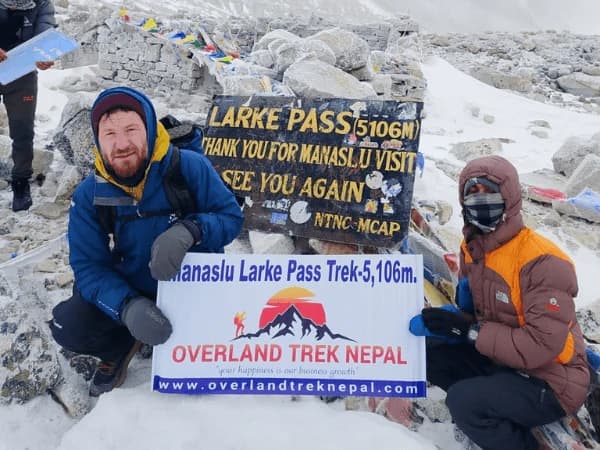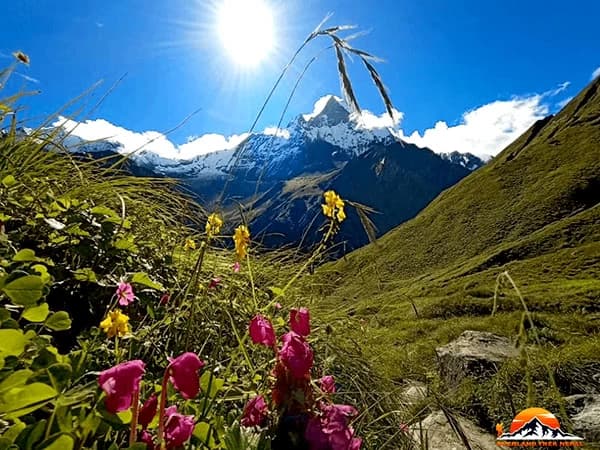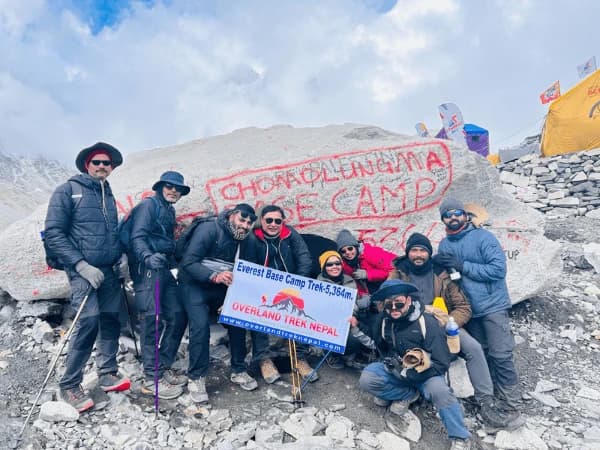Nepal Visa Requirement
Planning your adventure to Annapurna Base Camp starts with ensuring you can enter Nepal smoothly. Nepal’s visa requirements are fairly straightforward for most travelers. Nepal offers visas on arrival for citizens of most countries at Tribhuvan International Airport (Kathmandu) and land border checkpoints. This is the easiest option. When you arrive, you’ll fill out a form, pay the fee, and get a tourist visa sticker in your passport on the spot.
The standard tourist visa fees are USD 30 for 15 days, $50 for 30 days, and $125 for 90 days (multiple entry). Since the Budget Annapurna Base Camp Trek itself is 5 days, and maybe you’ll spend some extra days in Nepal, the 15-day visa usually suffices for a short trip.
Travel Insurance for Trekking
While dreaming of snowy peaks and lush valleys, it’s equally important to think of safety nets. Travel insurance for trekking in Nepal is highly recommended (essential, really) for any trekker, especially on a high-altitude trek like Annapurna Base Camp. Travel insurance provides financial protection and access to emergency assistance in case something goes wrong. When purchasing insurance, ensure it covers high-altitude trekkingup to 4,500 m (or above). Explicitly check that emergency medical evacuation (medevac) is included. This is crucial in Nepal. Policies often cover evacuation costs in full if deemed medically necessary by a doctor. Additionally, coverage for medical treatment is important – if you need to be hospitalized in Kathmandu or need treatment for broken bones, dehydration, severe AMS, etc., the policy should cover hospital bills up to a decent amount (e.g., $100,000 medical coverage or more). Thankfully, medical treatment in Nepal is relatively affordable, but you’d want the best care if something serious happened.
Eco Tourism Practice in the Annapurna Region
The Annapurna region isn’t just a trekkers’ playground; it’s a fragile environment and home to local communities who have stewarded these lands for generations. Practicing eco-tourism is crucial to preserving the beauty and integrity of this area for the future. Overland Trek Nepal is passionate about sustainable travel, and we encourage all our trekkers to follow eco-friendly practices on the Budget Annapurna Base Camp Trek.
Overland Trek Nepal integrates eco-tourism principles in all our treks. Our guides are trained to uphold these practices and will gently remind the group if, say, someone needs to pick up their candy wrapper or refrain from loud music that disturbs the serenity. We believe enjoying nature comes with the duty of protecting it. The Annapurna region has given so much to us trekkers in terms of joy and inspiration; let’s give back by treading as lightly as possible.
Traveling this way not only protects the environment, but it also often enriches your experience. You’ll find that the effort to be eco-friendly connects you more deeply to the place and its people. It’s all about traveling with respect. Together, let’s keep Annapurna beautiful for generations of trekkers to come!
Required Permits for the ABC Trek
For the Annapurna Base Camp Trek, you will need to secure an Annapurna Conservation Area Project Permit Card before hitting the trail. These permits are mandated by the Nepalese government and local authorities to regulate trekking, support conservation, and ensure safety. Don’t worry – Overland Trek Nepal, we’ll handle the paperwork for you. For foreign trekkers, the ACAP costs NPR 3,000 per person (about USD 25-30). SAARC country citizens have a discounted rate (NPR 1,000). Children under 10 years are often free.
If you trek with Overland, you’ll essentially be handing us two passport photos and a copy of your passport, paying the permit fees (included in our package quote usually), and we’ll return you the permits ready to go. It’s smooth and easy. Permits are not just formalities; they actively support keeping Annapurna’s trails open and beautiful. So, we appreciate your cooperation in obtaining them.
Essential Packing List for 5-Day ABC Trek
Packing for a trek is always a balancing act: you want to have everything you need for comfort and safety, but you also want to keep your backpack as light as possible, especially on a 5-day trek where you’ll be carrying it for long hours each day (unless you have a porter). Since this is a short Annapurna Base Camp Trek from Pokhara, you can afford to pack a bit lighter than on longer expeditions, but don’t skimp on the essentials. Here’s a comprehensive packing list, broken down into categories, to help you prepare for the Budget ABC trek:

Clothing:
- Trekking Shirts: 2-3 quick-dry, breathable shirts (synthetic or merino wool). You can do one long-sleeved and two short-sleeved. Layering is key.
- Trekking Pants: 1-2 pairs of lightweight, quick-drying pants. Convertible pants (zip-off to shorts) can be handy in changing temperatures. Shorts are okay for the lower parts, but above, you’ll likely want legs covered for warmth and sun protection.
- Insulating Jacket: A warm jacket for cold nights at Deurali and ABC. A lightweight down jacket or synthetic insulated jacket is ideal – it packs small but provides a lot of warmth. Nights at Annapurna Base Camp can drop below freezing even in peak seasons.
- Fleece or Sweater: A mid-layer like a fleece jacket or wool sweater for evenings or colder daytime.
- Base Layers: Thermal top and bottom (polypropylene or merino), especially for sleeping at ABC or if trekking in colder months. They also serve as pajamas.
- Waterproof Jacket (Raincoat): A good quality rain jacket (Gore-Tex or similar) that is waterproof and windproof. This will protect against rain as well as wind chill at higher altitudes. The weather in the mountains is unpredictable; you might encounter rain or even snow.
- Waterproof Pants: Optional but useful – lightweight rain pants that can go over your trekking pants in case of heavy rain or wind. For a 5-day trek, if the forecast looks clear, you might skip, but they’re nice to have insurance (they don’t weigh much).
- Underwear: Enough for 5 days (or you can wash a pair along the way). Moisture-wicking sports underwear is better than cotton. Ladies, sports bras for comfort.
- Warm Hat: A wool or fleece beanie that covers your ears. Essential for ABC’s cold mornings and nights.
- Sun Hat or Cap: For sun protection during the day at lower altitudes, the sun can be strong. A wide-brim hat or baseball cap works.
- Gloves: Warm gloves (fleece or wool) for higher up arms when it gets cold, especially in the morning/evening. If trekking in winter or early spring, consider waterproof gloves or layering a thin liner glove with a thicker glove.
- Buff/Scarf: A neck gaiter (buff) can serve multiple purposes – neck warmer, face mask (to protect from dust or cold air), headband, etc.
Footwear:
- Trekking Boots: A sturdy, worn-in pair of trekking boots is crucial. Choose water-resistant boots, have good ankle support and a reliable grip.
- Trekking Socks: 3-4 pairs of good-quality hiking socks (merino wool or synthetic blends).
- Camp Shoes/Sandals: After a long day of hiking, you’ll want to take off those boots. Bring a lightweight pair of sandals or flip-flops to wear at the teahouses and for using the bathroom/shower.
Trekking Gear:
- Trekking Poles, Water Bottle, Backpack of 60 L, Sleeping Bag, First Aid Kit, Sunglasses, Camera, Toiletries, and extra Nepalese Currency for the meals, and Accommodation.
Meals on a Budget Trek
One of the joys of trekking in Nepal is the experience of eating in the mountain teahouses. Even on a tight budget, you’ll find the food on the Annapurna Base Camp trek to be hearty, filling, and delicious. Meals are a social occasion on the trail – you’ll sit in a warm dining hall with fellow trekkers, guides, and locals, sharing stories over plates of steaming food. Let’s talk about what kind of meals to expect, how to manage costs, and some tips for eating well during your 5-day ABC trek:
Typical Foods you can find along the trail are: Dal Bhat, Noodle Soups, Fried Rice / Noodles, Momos, Western Dishes like pancakes, porridge, muesli, toast, and eggs for breakfast; pastas, macaroni, and even pizza for dinner at some lodges. Likewise, Potato Dishes, boiled potatoes with curry, hash browns, fried potatoes with cheese (often labeled as “Potato with Cheese”, a sort of au gratin).
Hot drinks are life on a cold trek. You will have a choice: black tea, milk tea (with milk and sugar), ginger tea, lemon tea, coffee (usually instant), hot lemon (vitamin C drink), and hot chocolate. Boiled water is cheaper than sealed bottles and supports the lodge. For example, 1 liter boiled might be $1.5-$2 in mid-level villages, $2-$3 at ABC.
Teahouse Trekking Experience in Annapurna
When you embark on the Budget Annapurna Base Camp Trek, you’re not just walking through stunning landscapes – you’re also stepping into the teahouse culture of the Himalayas. Teahouse trekking is a uniquely Nepali way of journeying, combining daily hikes with overnight stays in small, family-run lodges (teahouses) in villages along the trail. It’s an integral part of the Annapurna experience and one that trekkers often cherish as much as the scenery.
In the context of trekking, a teahouse is essentially a mountain lodge that offers basic accommodation and meals to trekkers. Rooms in teahouses are basic but comfortable enough for trekkers. Expect a twin-share room with two single beds (or occasionally a triple/quad in busier places, but the ABC route generally has twin rooms). The bed will have a foam mattress, a pillow, and usually a blanket.
Most teahouses now have a mix of squat toilets (ceramic or wooden hole in the floor) and some Western-style commodes. In lower villages, you might get a flush toilet, while higher up, it could be a drop toilet. Always carry your toilet paper, as mentioned. Bathrooms are shared, and you might have one or two per floor or per building. They are basic and sometimes a little rough, but usually kept clean enough by the owners (trekkers should do their part too!). It’s part of the adventure – and honestly, after a couple of days, using a squat loo by headlamp becomes oddly routine.
Transport from Pokhara to the Trailhead
One reason the Annapurna Base Camp trek can be done on a budget and in a short timeframe is because of the road connectivity that now reaches closer to the trailhead. Unlike some treks where you must walk for days or fly to a remote airstrip, for ABC, we can leverage ground transport to skip the lower foothills. The traditional trailhead for Annapurna Sanctuary treks used to be Nayapul (about a 1-1.5 hours’ drive from Pokhara). From Nayapul, people would trek via Birethanti and climb up to Ghandruk or Chhomrong over a couple of days. However, in recent years, rough roads have been extended further. Now, vehicles can go past Nayapul, through villages like Syauli Bazaar, Jhinu Danda, and even as far as Siwai or Matque (sometimes spelled Matkyu), which are very close to Chhomrong. On our itinerary, we typically drive to one of these end-of-road points: often Siwai/Matque (not far from Jhinu). This saves a huge chunk of time and walking (it cuts out what used to be 2 days of hiking to reach Chhomrong). The drive is bumpy but scenic, and it allows the trek to be just 5 days long, from Pokhara to Pokhara.
Guide and Porter Cost for ABC Trek
Hiring a guide and/or porter for your Annapurna Base Camp trek is highly recommended, and even with the added cost, it can still fit within a budget trek plan. In fact, as of 2023, trekking with a licensed guide is now mandatory in the Annapurna region, but beyond the rules, there are numerous benefits. Our guides at Overland Trek Nepal are locally born and trained. They know the route intimately, which means you won’t get lost and you can learn so much about each place you pass (local legends, mountain names, culture, etc.). A guide handles logistics: securing teahouse rooms ahead of your arrival (crucial in peak season), advising on the day’s plan, and obtaining necessary check-post stamps for permits. They also monitor your health, keeping an eye out for signs of altitude sickness and ensuring you acclimate properly. In case of any emergency or change of plans (like sudden weather issues or strikes), a guide manages the situation and rearranges things for you. Essentially, having a guide eliminates language barriers and stress, allowing you to focus on enjoying the trek. Even experienced trekkers find value in the insights and company of a good guide. And for first-time Nepal trekkers or solo travelers, a guide provides a sense of security – you’re not alone out there.
When you book with Overland, we’ll assign you a friendly guide (and porters as needed) who will meet you in Pokhara, help you prep, and lead you every step of the way to Annapurna Base Camp and back. Trekking with our crew, even a budget trek, feels rich with camaraderie.
Difficulty Level of Budget Annapurna Base Camp Trek
You might be wondering, “Can I do this trek? How hard is it?” The difficulty level of the Budget Annapurna Base Camp Trek is generally rated moderate, but with some challenging sections due to the rapid itinerary. Over 5 days of trekking, you’ll cover roughly 60 kilometers (37 miles) round-trip (this is an estimate, as exact distance varies with specific stop points). You will be hiking about 5 to 7 hours each day, except for a shorter 3-hour trek on Day 1 and perhaps a 4-hour descent on Day 5. The pace is fairly brisk because you’re essentially doing a trek that many do in 7+ days. That said, the trail is well-defined and there is no technical climbing involved – it’s all walking on mountain paths. The long days will test your endurance, especially the Day 2 ascent to Deurali and the Day 3 push to ABC. But with reasonable fitness, it’s very achievable.
Altitude Sickness and Remedies
Altitude sickness, also known as Acute Mountain Sickness (AMS), is a key concern on any trek that ventures above 3,000 meters. On the Annapurna Base Camp trek, the rapid ascent to over 4,000 m means we must be vigilant. The good news is that with proper precautions, most trekkers do not develop serious AMS, and in our short itinerary, we still take some measures to mitigate the risk. Risk on this Trek: We go from about 1,500 m to 4,130 m in three days. That’s a fast gain, so there is some risk of AMS, particularly at Deurali (3,230 m) and Annapurna Base Camp (4,130 m). Trekkers often feel fine until above 3,000 m, then mild symptoms can appear. The highest sleeping altitude on this trek is at ABC itself. Spending one night at that elevation is usually okay for a fit person, but some will experience mild headaches or poor sleep that night – that’s not uncommon. The design of the trek (we only spend a short time at max altitude and then descend) helps limit prolonged exposure.
Prevention Strategies:
- Stay Hydrated: Drink plenty of water – aim for 3-4 liters per day.
- Pacing and Rest: We encourage a slow ascent, even though the itinerary is fixed, you can walk at a comfortable pace.
- Avoid Alcohol and Smoking: On the trek, it’s best to refrain from alcohol or any smoking.
- Keep Warm and Eat Well: Sometimes, early signs of altitude issues (like a slight headache) can be worsened if you’re cold or not eating. Stay warm (cold stress can mimic AMS symptoms).
- Gradual Ascent/Extra Day (if possible): Our 5-day trek has no spare acclimatization day, but if someone is very prone to AMS, one could modify to add a rest day at, say, Chhomrong or Deurali.
- Proper Breathing: At altitude, a good trick is deep rhythmic breathing.
- Listen to Your Body: The best advice is, be honest about how you feel. There’s no shame in feeling the effects of altitude – it doesn’t mean you’re weak; it’s often genetics or just the day. Communicate with the guide about any symptoms, even mild.
Drinking Water, Electricity, and Internet Facilities
Staying hydrated, charged, and connected (at least occasionally) are practical aspects of any trek. Here’s what to expect regarding drinking water, electricity, and internet on the Annapurna Base Camp trek – especially relevant for those on a budget. Drinking Water:
Proper hydration is crucial at altitude, and you’ll need plenty of water each day. Buying bottled mineral water at every stop is both expensive and environmentally harmful (plastic waste). Instead, you can refill your bottle or buy boiled water for a few extra bucks. Each time you refill the bottle, it costs around USD 2-3 per bottle.
In summary, water, power, and connectivity are available albeit limited on the trek. Drinking water is easy to get – just purify it. Electricity is there – just budget a few bucks for charging or bring backup. The Internet exists in spots, but consider it a bonus rather than a given. Being prepared with the right gear (bottles, adapters, power bank) will ensure you stay healthy and keep your essential devices running.
Booking Procedure and Payment Method
Ready to take the leap and book your Budget Annapurna Base Camp Trek with Overland Trek Nepal? We strive to make the booking process as straightforward and transparent as possible. First, reach out to us with your interest in the Budget ABC Trek. You can contact us via our website, email us, or even call/WhatsApp at +9779851138871 our office. Let us know your preferred dates, number of trekkers, and any special requests (e.g., if you want to add a day, or link another trip like a safari or tour). We’ll promptly reply with availability and a detailed trip proposal.
Reservation and Deposit: Once you’re happy with the plan, to confirm the booking, we generally request a deposit. For our treks, a typical deposit might be around 20% of the total trip cost (exact amount will be informed). This deposit allows us to start arranging your permits, transport, guide, etc., and secure your spot. The remaining balance can often be paid upon arrival in Nepal (before the trek starts).
After the Trek – Feedback: When you’re back from the trek, we love to hear how it went! We might ask you to fill out a short feedback form or share a testimonial via Google or TripAdvisor.














